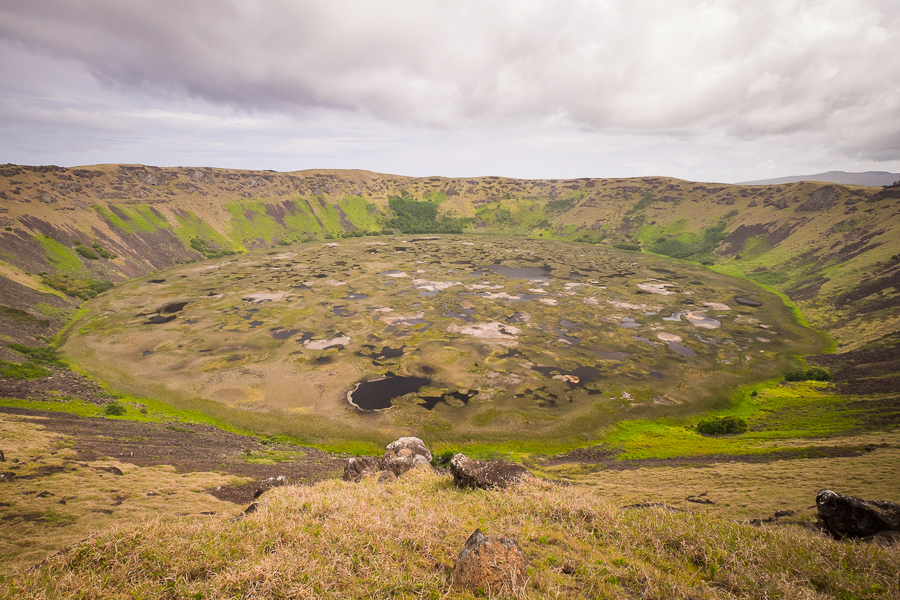Final day on the e-Bike was a bit of an easier one as I was just exploring the Rano Kau volcano and Orongo, both of which are right near Hanga Roa.
Started out early and was at 90% assistance getting up the volcano. Everybody who comes to Easter Island visits Orongo at the top of the volcano, but Pablo had told me about a hike around to the other side of the crater to a different viewpoint that he thought was really spectacular.
Found the Vai Atare track (no cars or bikes allowed) about ½ way up the mountain, chained the bike to itself and dumped it in some bushes on the side of the road, and started to hike. It wasn’t difficult at all and only took about 35 minutes, passing what looked to be more ceremonial circles of stones, as well as bluffs overlooking the ocean along the way.

The hike ended pretty much on other side of the gap in the crater (called Kari Kari – “the bitten part”) to where the Orongo Village is located. And Pablo was right. It is the most spectacular view on the island!

On one side, you have the Rano Kau wetlands down in the crater itself. More than a kilometre across, 200m deep and offering protection from the winds that constantly blow across the island, the crater generates its own microclimate and is able to sustain cattail plants similar to those found at Lake Titicaca in Peru (another link to South America).

On the other side, you have the ocean with the islands most important to the Birdman Cult – Motu Nui, the smaller Motu Iti, and the isolated Motu Kau Kau – framed by the gap in the crater.

I ended up hanging out there by myself (the other nice thing is that few people go there) and with my falcon friend (who was swooping me like a magpie) for over an hour, eating my lunch and admiring the view. Then it was back the way I came and onto the bike to tackle the rest of the volcano.
Stopped off at the regular viewpoint over the crater a little further up the hill – which is a wonderful view, but not as good as the one I just left.

And then onto Orongo – one of the two sites on the island that you can only visit once. I asked the Guardaparque there why that was and he explained that it was because of the number of tourists that come to Easter Island these days. If they allowed everyone to come to Orongo as often as they wanted, then there would be many more visitors each day and the site would deteriorate much faster. Fair enough – so headed out with my interpretive map to explore the village of the Birdman Cult.

The 53 “houses” are constructed of stacked slate and are oval in design with double outer walls and a very low entrance.

The village was used for only a few weeks per year – mostly for preparation for the Birdman competition, where the chiefs of the different tribes or their hopu (representatives) would compete to gather the first sooty tern (manu tara) egg of the year. Participants would descend the sea cliff and swim to Motu Nui, staying there for days or weeks awaiting the arrival of the seabirds, until one of them found an egg and returned it intact to Orongo. He (or the Chief he represented) then became tangata-manu – the sacred birdman – and lived in ceremonial reclusion for one year. Hmmm…. not the reward I would have gone for!
There are also a lot of stone carvings in the village, it is the manner by which the Birdman cult chose to express themselves, but unfortunately the area where most of them are found was roped off to protect it (and visitors) from slippage.

For me, while Orongo is interesting, it is not as interesting as the rest of the island to be honest. Definitely worth a visit though, and if you don’t want to/can’t walk out to the Vai Atare lookout, it has the next best view of the Birdman islands.
